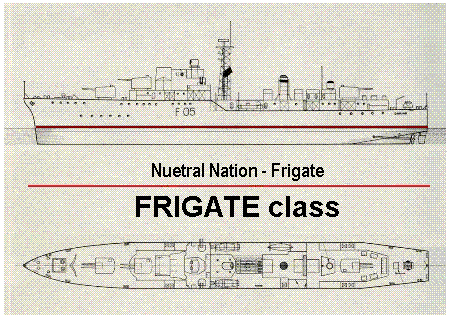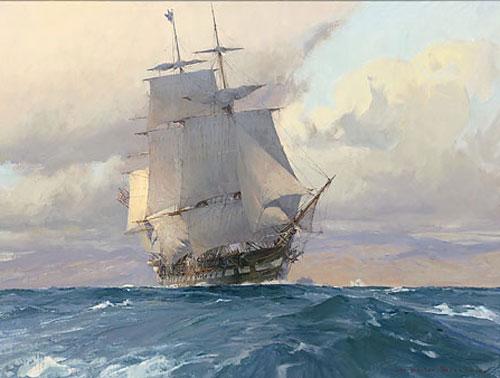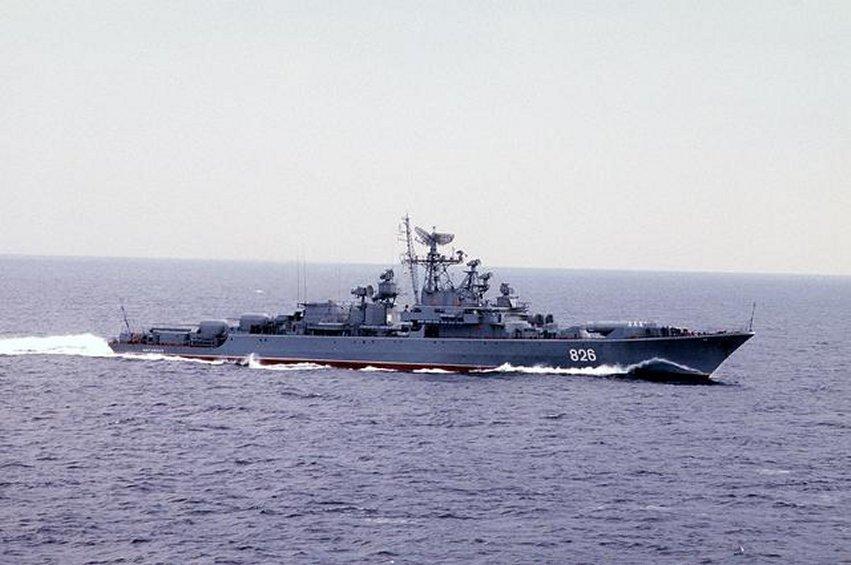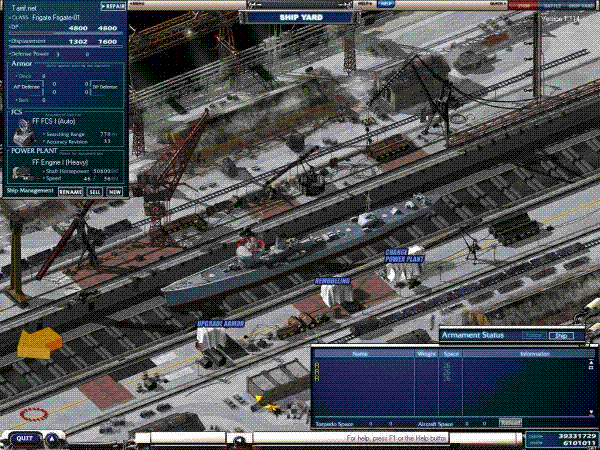
Neutral Nation - FRIGATE class ==========================================================================

A frigate is a warship. The term has been used for warships of many sizes and roles over the past few centuries.
The term "frigate" (Italian: fregata; Spanish/Catalan/Portuguese/Sicilian: fragata; Dutch: "fregat") originated in the Mediterranean in the late 15th century, referring to a lighter galleass type ship with oars, sails and a light armament, built for speed and maneuverability.
In the 18th century, the term referred to ships which were as long as a ship-of-the-line and were square-rigged on all three masts (full rigged), but were faster and with lighter armament, used for patrolling and escort. In the 19th century, the armoured frigate was a type of ironclad warship and for a time was the most powerful type of vessel afloat.
In modern navies, frigates are used to protect other warships and merchant-marine ships, especially as anti-submarine warfare (ASW) combatants for amphibious expeditionary forces, underway replenishment groups, and merchant convoys. But ship classes dubbed "frigates" have also more closely resembled corvettes, destroyers, cruisers and even battleships.

The navy of the Dutch Republic was the first regular navy to build the larger ocean-going frigates. In 1583, during the Eighty Years' War, Habsburg Spain recovered the Southern Netherlands from the rebellious Dutch. This soon led to the occupied ports being used as bases for privateers, the Dunkirkers, to attack the shipping of the Dutch and their allies.
The Dutch navy had three principal tasks in the struggle against Spain: - to protect Dutch merchant ships at sea, to blockade the ports of Spanish-held Flanders to damage trade and halt enemy privateering, and to fight the Spanish fleet and prevent troop landings. The first two tasks required speed, shallowness of draft for the shallow waters around the Netherlands, and the ability to carry sufficient supplies to maintain a blockade. The third task required heavy armament, sufficient to fight against the Spanish fleet. The first of these larger battle-capable frigates were built around 1600 at Hoorn in Holland. By the later stages of the Eighty Years War the Dutch had switched entirely from the heavier ships still used by the English and Spanish to the lighter frigates, carrying around 40 guns and weighing around 300 tons.
The effectiveness of the Dutch frigates became most visible in the Battle of the Downs in 1639, triggering most other navies, especially the English, to adopt similar innovations.
The classic sailing frigate, well-known today for its role in the Napoleonic wars, can be traced back to French developments in the second quarter of the 18th century. The French-built Médée of 1740 is often regarded as the first example of this type. These ships were square-rigged and carried all their main guns on a single gun deck which replaced the upper gun deck on earlier similarly-sized two-decked ships. The lower deck, known as the "gun deck", now carried no armament, and functioned as a "berth deck" where the crew lived, and was in fact placed below the waterline of the new frigates. The new sailing frigates were able to fight with all their guns when the seas were so rough that comparable two-deckers had to close the gun-ports on their lower decks. Like the larger 74 which was developed at the same time, the new frigates sailed very well and were good fighting vessels due to a combination of long hulls and low upperworks compared to vessels of comparable size and firepower.
The Royal Navy captured a handful of the new French frigates during the early stages of the Seven Years' War (1756–1763) and were impressed by them, particularly for their inshore handling capabilities. They soon built copies and started to adapt the type to their own needs, setting the standard for other frigates as a superpower.
Frigates were perhaps the hardest-worked of warship types during the Age of Sail. While smaller than a ship-of-the-line, they were formidable opponents for the large numbers of sloops and gunboats, not to mention privateers or merchantmen. Able to carry six months' stores, they had very long range; and vessels larger than frigates were considered too valuable to operate independently.
Frigates scouted for the fleet, went on commerce-raiding missions and patrols, conveyed messages and dignitaries. Usually frigates would fight in small numbers or singly against other frigates. They would avoid contact with ships-of-the-line; even in the midst of a fleet engagement it was bad etiquette for a ship of the line to fire on an enemy frigate which had not fired first.
For officers in the Royal Navy a frigate was a desirable posting. Frigates often saw action, which meant a greater chance of glory, promotion, and prize money.
Frigates are often the vessel of choice in historical naval novels, such at the Patrick O'Brian Aubrey–Maturin series and C. S. Forester's Horatio Hornblower series. The motion picture Master and Commander features a reconstructed historic frigate, HMS Rose to depict Aubrey's frigate HMS Surprise.
Frigates remained a crucial element of navies until the mid-19th century. The first ironclads were classified as 'frigates' because of the number of guns they carried. However, terminology changed as iron and steam became the norm, and the role of the frigate was assumed first by the protected cruiser and then by the destroyer.
Vessels classed as frigates continued to play a great role in navies with the adoption of steam power in the 19th century. In the 1830s navies experimented with large paddle-steamers equipped with large guns mounted on one deck, which were termed 'paddle frigates'. From the mid-1840s frigates which more closely resembled the traditional sailing frigate were built with steam engines and screw propellers. These 'screw frigates', built first of wood and later of iron, continued to perform the traditional role of the frigate until late in the 19th century.
From 1859, armour was added to ships based on existing frigate and ship of the line designs. The additional weight of the armour on these first ironclad warships meant that they could have only one gun deck, and they were technically frigates, even though they were more powerful than existing ships-of-the-line and occupied the same strategic role. The phrase 'armoured frigate' remained in use for some time to denote a sail-equipped, broadside-firing type of ironclad.
Towards the end of the 19th century, the term 'frigate' fell out of use. Armoured vessels were designated as either 'battleships' or 'armoured cruisers', while unarmoured vessels including frigates and sloops were classified as 'unprotected cruisers'.
The modern frigate appeared during World War II as an easily built patrol and convoy escort vessel. Modern frigates are related to earlier frigates only by name. Modern frigates are small, maneuverable, lightly armed warships. The term "frigate" was readopted during World War II by the British Royal Navy to describe a new type of anti-submarine escort vessel that was larger than a corvette, but smaller than a destroyer. The frigate was introduced to remedy some of the shortcomings inherent in the corvette design: limited armament, a hull form not suited to open-ocean work, a single shaft which limited speed and maneuverability, and a lack of range. The frigate was designed and built to the same mercantile construction standards (scantlings) as the corvette, allowing manufacture by yards unused to warship construction. The first frigates of the River class (1941) were essentially two sets of corvette machinery in one larger hull, armed with the latest Hedgehog anti-submarine weapon. The frigate possessed less offensive firepower and speed than a destroyer, but such qualities were not required for anti-submarine warfare. Submarines were slow, and ASDIC sets did not operate effectively at speeds of over 20 knots. Rather, the frigate was an austere and weatherly vessel suitable for mass-construction and fitted with the latest innovations in anti-submarine warfare. As the frigate was intended purely for convoy duties, and not to deploy with the fleet, it had limited range and speed.

The contemporaneous German Flottenbegleiter ("fleet escorts"), also known as "F-Boats" were essentially frigates. They were based on a pre-war Oberkommando der Marine concept of vessels which could fill roles such as fast minesweeper, minelayer, merchant escort and anti-submarine vessel. Because of the Treaty of Versailles their displacement was officially limited to 600 tons, although in reality they exceeded this by about 100 tons. F-boats had two stacks and two 105 mm gun turrets. The design was flawed because of its narrow beam, sharp bow and unreliable high pressure steam turbines. F-boats suffered relatively heavy losses and were succeeded in operational duties later in the war by Type 35 and Elbing class torpedo boats. Flottenbegleiter remained in service as advanced training vessels.
It was not until the Royal Navy's Bay class of 1944 that a British design bearing the name of frigate was produced for fleet use, although it still suffered from limited speed. These frigates were similar to the United States Navy's (USN) destroyer escorts (DE), although the latter had greater speed and offensive armament to better suit them to fleet deployments. American DEs serving in the British Royal Navy were rated as frigates, and British-influenced Tacoma class frigates serving in the USN were classed as patrol frigates (PF). One of the most successful post-1945 designs was the British Leander class frigate, which was used by several navies.

=================================================================================
NB: The above text has been collected / excerpted / edited / mangled / tangled / re-compiled / etc ... from the following online sources :
Neutral - FRIGATE class - wikipedia article #1



